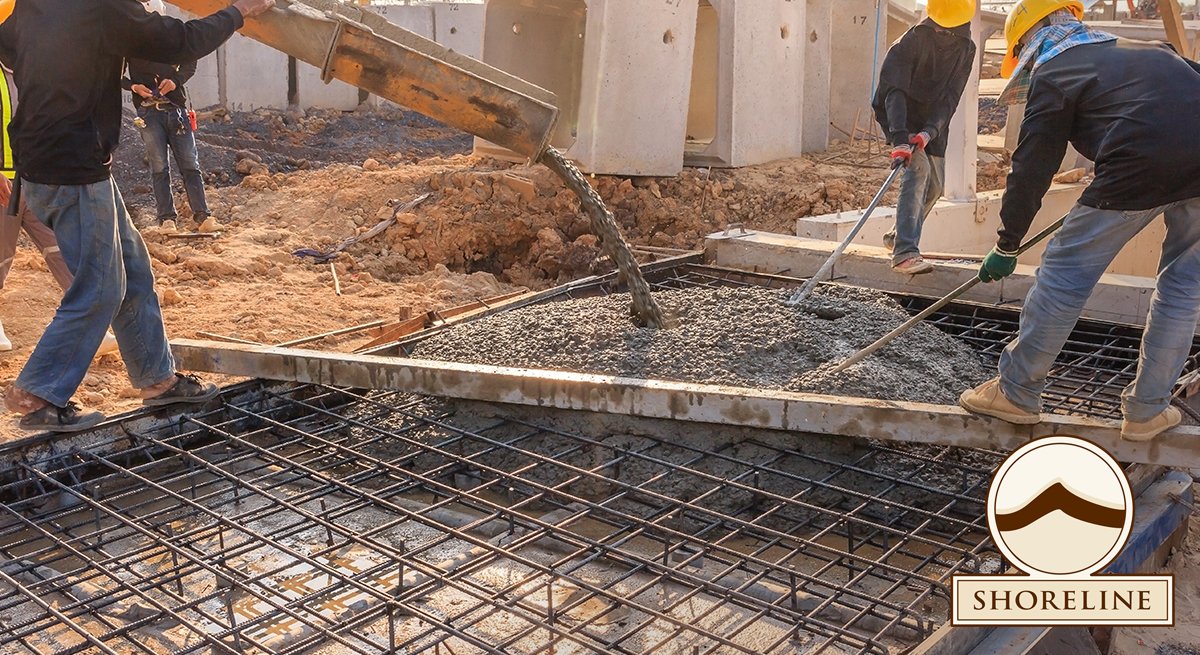Estimated reading time: 7 minutes
In the construction industry, Aggregates are one of the most important components for cement and concrete. Aggregates can be found in the concrete that makes up sidewalks, roads, bridges, railroads, airport runways, and more. This article will focus on Aggregates’ importance in the creation of concrete for the Construction industry.
Table of contents
What are aggregates?
Aggregates are raw materials that are produced from natural sources and extracted from pits and quarries, including gravel,crushed stone, and sand. When used with a binding medium, like water and cement, they are used to form compound materials, such as asphalt concrete and Portland cement concrete.
In 2018, according to the U.S. Geological Survey Mineral Commodity Summary, 75 percent of the 1.4 billion tons of crushed stone produced was used in construction. Meanwhile, of the almost 1 billion tons of sand and gravel produced, 24 percent was used in road construction, 12 percent in asphalt, and 44 percent in concrete.
The difference between cement and concrete
Although the terms cement and concrete often are used interchangeably, cement is an actually just ingredient of concrete.
Concrete is a durable building material that uses cement as one of its components. There are four primary ingredients in concrete: cement, stone, sand, and water. The less water that is added to a concrete mixture, the stronger that mixture will be.
The water used in concrete activates the cement, which acts as the binding agent. Aggregates (coarse and fine) in the mix are bound together by the cement. Mixes that use larger aggregates tend to be stronger than those with finer aggregates.
Cement comprises from 10-15% of the concrete mix. Through a process called hydration, the cement and water harden and bind the aggregates into a rocklike mass. This hardening process continues for years meaning that concrete gets stronger as it gets older.
Though both cement and concrete are vital to the construction industry, concrete is the final product used in the building process. Now you know – there is no such thing as a cement sidewalk, or cement mixer. The proper terms are concrete sidewalk and concrete mixer.
How is concrete essential to construction?
Concrete forms a crucial part of any building or structure. Just look at the buildings that surround you, the pavements you walk on, and other various structures around. Concrete is everywhere.
Because of its durability and strength, concrete is a very popular building material. It comprises everything from the drainage culverts that run beneath our streets to the walls of modern homes. It forms the core of many of our skyscrapers and makes up the sidewalks we walk down every day.
Concrete can be molded into any shape when newly mixed. Because of its versatility, construction workers can simply pour concrete into whatever shapes they need and then install those without having to shape, bend, cut, or weld the pieces. Architects appreciate concrete for its energy efficiency and the safety it brings to a space.
Another reason concrete is vital to construction is because of its similarity to mortar in both composition and structure. This means concrete works as a binder for the various masonry units in construction, just like any mortar. Unlike ordinary mortar, however, concrete has a wide range of applications. This versatility is a result of concrete having both fine aggregates and coarse aggregates that are larger. The large size of the coarse aggregates gives a strength to concrete that mortar does not have. This makes it suitable for application in larger and heavier structures. Most mortars have sand as the sole aggregate and are hence weaker than concrete.
The strength of concrete makes it suitable for constructing foundations, wastewater treatment facilities, super structures, and other establishments.
Concrete’s makeup allows it to lasts for years – even under very adverse conditions. Concrete can resist weathering action, chemical action, abrasion, and both tensile and compressive stress for long periods without compromising its structural integrity. This attribute makes a concrete structure more stable and suitable for places with rough conditions.
Commercial concrete work require little maintenance save from a few touch-ups on the finishing. The longevity of concrete makes it a great material for permanent buildings and other structures like bridges and even dams.
Industry Highlight
Slag is used as the surface material at the Indianapolis Motor Speedway because its angular, sharp texture creates excellent traction and skid resistance.What are the different types of cement used in concrete?
The most common types of cement used in the construction industry are Portland cement and Asphalt cement. These are not brand names, but the generic terms for the type of cement used in virtually all concrete, just as stainless is a type of steel and sterling a type of silver.
Portland cement is one of the most important ingredients in concrete. It may be in either a dry powdery form before water is added or the paste (mortar) that hardens and binds to whatever it’s touching.
Portland cement is made of a few primary substances, including limestone, sand or clay, bauxite, and iron ore. It may also include shells, chalk, marl, shale, slag, and slate. These different components are mixed and heated in cement processing plants to form a rock-hard substance called clinker. The clinker is then ground down to the powder that can be mixed with water to form a paste.
Asphalt cement is a strong, versatile, and weather- and chemical-resistant binding material that adapts itself to a variety of uses, perhaps most commonly to bind crushed stone and aggregate into a firm, tough surface for roads, streets and airport runways.
What are the benefits of using quality aggregates in concrete mix?
The key to achieving a strong, durable concrete rests on the careful proportioning and mixing of the ingredients. A concrete mixture that does not have enough paste to fill all the voids between the aggregates will be difficult to place and will produce rough, honeycombed surfaces and porous concrete. A mixture with an excess of cement paste will be easy to place and will produce a smooth surface; however, the resulting concrete will be more likely to crack and be uneconomical.
A properly proportioned concrete mixture will possess the desired workability for the fresh concrete and the required durability and strength for the hardened concrete.
Aggregates for concrete are chosen carefully. Aggregates comprise 60-75% of the total volume of concrete. The type and size of the aggregate mixture depends on the thickness and purpose of the final concrete product. Relatively thin buildings sections can require small coarse aggregates, though aggregates up to six inches (150 mm) in diameter have been used in large dams. A continuous gradation of particle sizes is desirable for efficient use of the paste. In addition, aggregates should be clean and free from any matter that might affect the quality of the concrete.
Aggregates in Concrete Facts
- Aggregates make up some 60-80% of the concrete mix. They provide compressive strength and bulk to concrete.
- Aggregates in any mix of concrete are selected for their durability, strength, workability and ability to receive finishes.
- For a good concrete mix, aggregates need to be clean, hard, strong particles free of absorbed chemicals or coatings of clay and other fine materials that could cause the deterioration of concrete.
- Aggregates are divided into either ‘coarse’ or ‘fine’ categories.
- Coarse aggregates are particulates that are greater than 4.75mm. The usual range employed is between 9.5mm and 37.5mm in diameter.
- Fine aggregates are usually sand or crushed stone that are less than 9.55mm in diameter.
- Typically, the most common size of aggregate used in construction is 20mm. A larger size, 40mm, is more common in mass concrete.
- Larger aggregate diameters reduce the quantity of cement and water needed.


